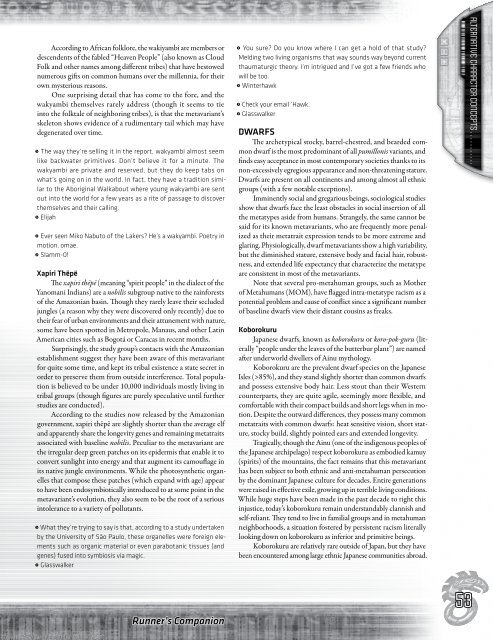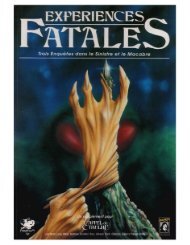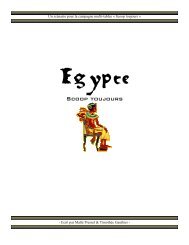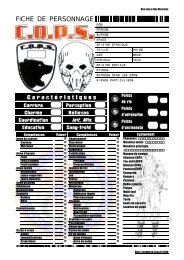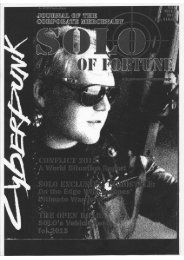Runner's Companion.pdf - Free
Runner's Companion.pdf - Free
Runner's Companion.pdf - Free
- No tags were found...
You also want an ePaper? Increase the reach of your titles
YUMPU automatically turns print PDFs into web optimized ePapers that Google loves.
Simon Wentworth (order #1132857) 9According to African folklore, the wakiyambi are members ordescendents of the fabled “Heaven People” (also known as CloudFolk and other names among different tribes) that have bestowednumerous gifts on common humans over the millennia, for theirown mysterious reasons.One surprising detail that has come to the fore, and thewakyambi themselves rarely address (though it seems to tieinto the folktale of neighboring tribes), is that the metavariant’sskeleton shows evidence of a rudimentary tail which may havedegenerated over time.> The way they’re selling it in the report, wakyambi almost seemlike backwater primitives. Don’t believe it for a minute. Thewakyambi are private and reserved, but they do keep tabs onwhat’s going on in the world. In fact, they have a tradition similarto the Aboriginal Walkabout where young wakyambi are sentout into the world for a few years as a rite of passage to discoverthemselves and their calling.> Elijah> Ever seen Miko Nabuto of the Lakers? He’s a wakyambi. Poetry inmotion, omae.> Slamm-0!Xapiri ThëpëThe xapiri thëpë (meaning “spirit people” in the dialect of theYanomani Indians) are a nobilis subgroup native to the rainforestsof the Amazonian basin. Though they rarely leave their secludedjungles (a reason why they were discovered only recently) due totheir fear of urban environments and their attunement with nature,some have been spotted in Metropole, Manaus, and other LatinAmerican cities such as Bogotá or Caracas in recent months.Surprisingly, the study group’s contacts with the Amazonianestablishment suggest they have been aware of this metavariantfor quite some time, and kept its tribal existence a state secret inorder to preserve them from outside interference. Total populationis believed to be under 10,000 individuals mostly living intribal groups (though figures are purely speculative until furtherstudies are conducted).According to the studies now released by the Amazoniangovernment, xapiri thëpë are slightly shorter than the average elfand apparently share the longevity genes and remaining metatraitsassociated with baseline nobilis. Peculiar to the metavariant arethe irregular deep green patches on its epidermis that enable it toconvert sunlight into energy and that augment its camouflage inits native jungle environments. While the photosynthetic organellesthat compose these patches (which expand with age) appearto have been endosymbiotically introduced to at some point in themetavariant’s evolution, they also seem to be the root of a seriousintolerance to a variety of pollutants.> What they’re trying to say is that, according to a study undertakenby the University of São Paulo, these organelles were foreign elementssuch as organic material or even parabotanic tissues (andgenes) fused into symbiosis via magic.> Glasswalker> You sure? Do you know where I can get a hold of that study?Melding two living organisms that way sounds way beyond currentthaumaturgic theory. I’m intrigued and I’ve got a few friends whowill be too.> Winterhawk> Check your email ‘Hawk.> GlasswalkerDWARFSThe archetypical stocky, barrel-chestred, and bearded commondwarf is the most predominant of all pumillonis variants, andfinds easy acceptance in most contemporary societies thanks to itsnon-excessively egregious appearance and non-threatening stature.Dwarfs are present on all continents and among almost all ethnicgroups (with a few notable exceptions).Imminently social and gregarious beings, sociological studiesshow that dwarfs face the least obstacles in social insertion of allthe metatypes aside from humans. Strangely, the same cannot besaid for its known metavariants, who are frequently more penalizedas their metatrait expression tends to be more extreme andglaring. Physiologically, dwarf metavariants show a high variability,but the diminished stature, extensive body and facial hair, robustness,and extended life expectancy that characterize the metatypeare consistent in most of the metavariants.Note that several pro-metahuman groups, such as Motherof Metahumans (MOM), have flagged intra-metatype racism as apotential problem and cause of conflict since a significant numberof baseline dwarfs view their distant cousins as freaks.KoborokuruJapanese dwarfs, known as koborokuru or koro-pok-guru (literally“people under the leaves of the butterbur plant”) are namedafter underworld dwellers of Ainu mythology.Koborokuru are the prevalent dwarf species on the JapaneseIsles (>85%), and they stand slightly shorter than common dwarfsand possess extensive body hair. Less stout than their Westerncounterparts, they are quite agile, seemingly more flexible, andcomfortable with their compact builds and short legs when in motion.Despite the outward differences, they possess many commonmetatraits with common dwarfs: heat sensitive vision, short stature,stocky build, slightly pointed ears and extended longevity.Tragically, though the Ainu (one of the indigenous peoples ofthe Japanese archipelago) respect koborokuru as embodied kamuy(spirits) of the mountains, the fact remains that this metavarianthas been subject to both ethnic and anti-metahuman persecutionby the dominant Japanese culture for decades. Entire generationswere raised in effective exile, growing up in terrible living conditions.While huge steps have been made in the past decade to right thisinjustice, today’s koborokuru remain understandably clannish andself-reliant. They tend to live in familial groups and in metahumanneighborhoods, a situation fostered by persistent racism literallylooking down on koborokuru as inferior and primitive beings.Koborokuru are relatively rare outside of Japan, but they havebeen encountered among large ethnic Japanese communities abroad.alternative character concepts . . . . . . . . . . .Runner’s <strong>Companion</strong>53


